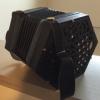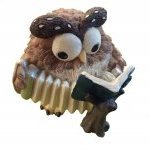-
Posts
98 -
Joined
-
Last visited
Profile Information
-
Gender
Male
-
Interests
Anglo concertina, clawhammer banjo, baritone ukulele, guitar and (occasionally) tenor banjo.
-
Location
Homewood, AL
Recent Profile Visitors
1,256 profile views
MJGray's Achievements

Advanced Member (3/6)
-

Concertinas At Sea: A History Of A Nautical Icon
MJGray replied to Dan Worrall's topic in General Concertina Discussion
And well worth your time they are, too! Here are the Google Books links: Volume 1 = https://www.google.com/books/edition/The_Anglo_German_Concertina/1-thWE5XRmsC Volume 2 = https://www.google.com/books/edition/The_Anglo_German_Concertina/JKZO1aevsiIC Thanks for writing them, Dan! I very much enjoyed reading them when I was first picking up the concertina. -Mike -
Well, to an extent, but every choice of instrument is also a choice of repertoire, and a musician's choice of instrument does reflect that taste and inner desire. A piano is not a sitar is not a kora is not an shamisen, etc. etc. I pick up the banjo for a very different set of tunes than I pick up the concertina, and those are both pretty solidly set in Western musical traditions. I honestly don't think it's a weakness of an instrument to be better at some things than others. Genuine virtuosos can transcend those limitations, but each instrument has strengths that lend themselves to particular kinds of music. So I suppose my answer to the OP's question is "I don't", and will either transpose into a key that works or play a different instrument better suited to that particular tune. I make no pretensions of virtuosity, though 🙂
-
Sadly, I've never known any substitute for repetition for instilling muscle memory. However, a little research suggests that there are ways to do a better job, largely by careful structuring of those repetitions. A couple of interesting links that have me thinking about ways I can improve my own practice: https://www.washingtonpost.com/news/wonk/wp/2016/02/12/how-to-learn-new-skills-twice-as-fast/ https://www.guitartricks.com/blog/Improve-Muscle-Memory-With-These-8-Easy-Tips
-
I bought a Clover from Bob a few years ago and have been very happy with it. Mike
-
This might help: https://www.bushtraditions.org/tutors/concertina.htm There's a pinned thread called "Instruction Books for Concertina" in the Teaching and Learning forum that has a much more extensive list of available resources.
-

Beginner help - Anglo or Hayden Duet?
MJGray replied to Darabin's topic in General Concertina Discussion
I have no idea about duet concertinas (others will be far more helpful there), but it's certainly true that there are many more resources for learning the Anglo. As long as you're not too concerned about playing easily in multiple keys, the Anglo sounds like it would fit your needs pretty well. -

How to Add Depth/Richness When Using Music Not Written For Concertina
MJGray replied to Smcd's topic in Teaching and Learning
To add one little trick that I've found both easy and useful: playing the melody in octaves adds a nice richness to a simple tune, and is straightforward on the 20b Anglo (certainly easier than bass lines and chords!). https://www.concertinajournal.org/House_Dance_Text/ch_2.htm -
Glad you found it entertaining! I have to admit I didn't notice the left hand notes being transposed an octave down, because I learned to read music as a clarinet player in junior high and never had any cause to use a bass clef. 🙂
-
Well, that's very interesting. I like it. I would probably add some button numbers, but it didn't occur to me to change the shape of the note heads. That would make it so you only needed numbers 1 - 5, even for a 3-row instrument. Just what we needed: another tablature system! 🙂
-
Me too! The "notated clearly" is definitely a key part. There have been some real historical failures on that front. I've been digging through more old books, and Carlo Minasi (https://archive.org/details/imslp-book-for-the-use-of-learners-of-the-german-concertina-minasi-carlo/page/n19/mode/2up), while I'm sure he was an upstanding musician, used a truly baffling system of notation: Here you can see not only the cluttering problem and the utter failure of "p" and "d" as useful bellows direction indicators, but a weird sort of cross-hair to indicate when he thinks you should use the air valve and (worst of all, in my mind) using the numbers 1 - 5 for the buttons on each row, with an open circle (the same size as a note!) to indicate notes played on the G row. Oof. I guess the other thread has made clear that what's "intuitive" for different people is very different, but I like that this conversation is maybe helping to establish some kind of "best practices" in the community as it exists now. I'm starting to realize that clarifying what, exactly, people want out of tablature is also important. It seems like Roger is most interested in translating dots / ABC into tablature to more quickly be able to play new melodies, and has built an amazing tool to do that, while your goal seems to be documenting the details of a specific arrangement. Both excellent goals, but ones that require different approaches! - Mike
-
Very cool. I like the way that looks a lot. Thank you for sharing!
-
Interesting! Would you be willing to share an example so we can see how it looks?
-
Interesting! By ABT, I presume you mean Australian Bush Traditions? I like that site a lot, and can definitely see the advantages of the system, although the symmetrical button numbering throws me off every time. Lower numbers = lower notes makes more sense in my head. Thank you for including the ABC code, too. Being able to encode tabs that way is huge! EDIT: Do you have any way to include harmonic accompaniment, or is that just something you don't worry about?
-
Agreed! I think your second point is particularly important, and is probably leading the community towards it as a kind of standard.





